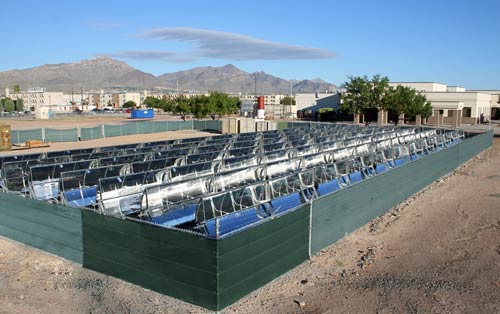Sopogy thrives by thinking big

A solar-powered air-conditioning system designed by Honolulu-based Sopogy Inc. is part of an effort by Fort Bliss, a U.S. Army post, to reach energy independence by 2015. The project uses Sopogy's MicroCSP technology, which is also used for power generation.
From its modest headquarters in an industrial area near Honolulu Airport, homegrown high-tech company Sopogy Inc. is taking on some of the world’s biggest names in renewable energy.
Launched in 2002 by local entrepreneur Darren Kimura, Sopogy has leveraged its expertise in the field of concentrated solar power to win contracts on the mainland and across the globe. Among its competitors are Siemens AG, a German conglomerate with a market capitalization of $116 billion, and Spain’s Abengoa SA, another multibillion-dollar firm.
Sopogy, which pioneered the development of "MicroCSP" technology, recently announced its biggest deal to date: the installation of 200 megawatts of generating capacity in China.
"Sopogy is a perfect example of a tech company that has hit a home run in Hawaii," said Bill Spencer, president of the Hawaii Venture Capital Association. "Darren is a testament to how a technology company in Hawaii can seek out a global market and deliver. There are no boundaries if it is done properly."
Sopogy’s patented system is a variation on an older solar energy technology first tested 30 years ago in the Mojave Desert. The Department of Energy oversaw the project near Barstow, Calif., that featured huge mirrored troughs used to concentrate solar energy and create steam that turned a turbine to generate electricity.
Kimura and his team took the technology, scaled down the troughs to one-fourth of the size and made other improvements that resulted in the systems being more mobile and less costly. Since completing research and development in 2005 Sopogy has installed six MicroCSP systems and has at least six more in the development stage. Project locations include Abu Dhabi, Mexico and Papua New Guinea.
Don't miss out on what's happening!
Stay in touch with breaking news, as it happens, conveniently in your email inbox. It's FREE!
The company has been growing at about 300 percent a year since 2005, but Kimura said he expects that to slow to a mere 60 percent to 80 percent annually in the coming years.

The 37-year-old Kimura, who launched his first company while a student at the University of Hawaii, has assembled an impressive management team that includes former Kamehameha Schools Vice President Michael Loo as chief financial officer.
Kimura remains chairman of the board of Energy Industries, an energy-efficiency consulting firm he launched in 2004 that now has offices across the western U.S., Hawaii, Guam and Japan.
"I can still say that all my companies are based here because that’s fundamental to what I do," Kimura said. "I’m trying to develop an energy industry here that we can use to create critical mass."
Kimura’s commitment to Hawaii, both through his business ventures and community outreach, will help pave the way for future local entrepreneurs looking to get ventures off the ground here, said Yuka Nagashima, president of the Hawaii Technology Development Corp.
"He’s very community oriented. He’s passing along his experience, and the more successful companies that Hawaii produces, the easier it will be for the rest of us," Nagashima said.
"It helps counter the image of Hawaii as only a tourist destination."
Sopogy was one of several Hawaii startups that benefited from a now-defunct state program known as Act 221 that provided tax breaks to investors who put money into local tech companies.
"It made people more willing to invest in Hawaii companies. That’s why I supported 221," Spencer said. "We needed a way to get people to invest in Hawaii. At the same time, we have to have confidence in our entrepreneurs. We just needed to prime the pump," he said.
Sopogy has 42 patents in various stages on its technology, Kimura said. One of the breakthroughs the company was able to achieve through its R&D was a way to use the heat from its solar collectors to turn a turbine without using steam. Standard CSP systems, as well as many oil-fired generators, use steam to turn turbines. But using steam requires a constant supply of fresh water. In addition, steam corrodes turbine blades, requiring frequent maintenance.
Sopogy’s system instead uses a thermodynamic cycle that achieves the same results without using steam, Kimura said. Parabolic mirrors made of polished aluminum are used to collect sunlight and focus it on a tube carrying a heat-transfer fluid, usually mineral oil. The mineral oil is heated to about 500 degrees Fahrenheit and pumped through an evaporator where the heat is used to vaporize a liquid refrigerant. The vapors turn a turbine that generates electricity. The mineral oil is then sent back to the mirrors to be reheated. The vaporized refrigerant is cooled and returned to a liquid state to be used again.
Sopogy also uses its MicroCSP technology to power air-conditioning systems using an absorption cooling process. The system works in much the same as a natural gas air-conditioning system.
In both systems, water is heated to temperatures just cooler than 200 degrees and collected in a storage tank. The water then goes through an absorption chiller that cools the cold water used in the building’s fan units.




